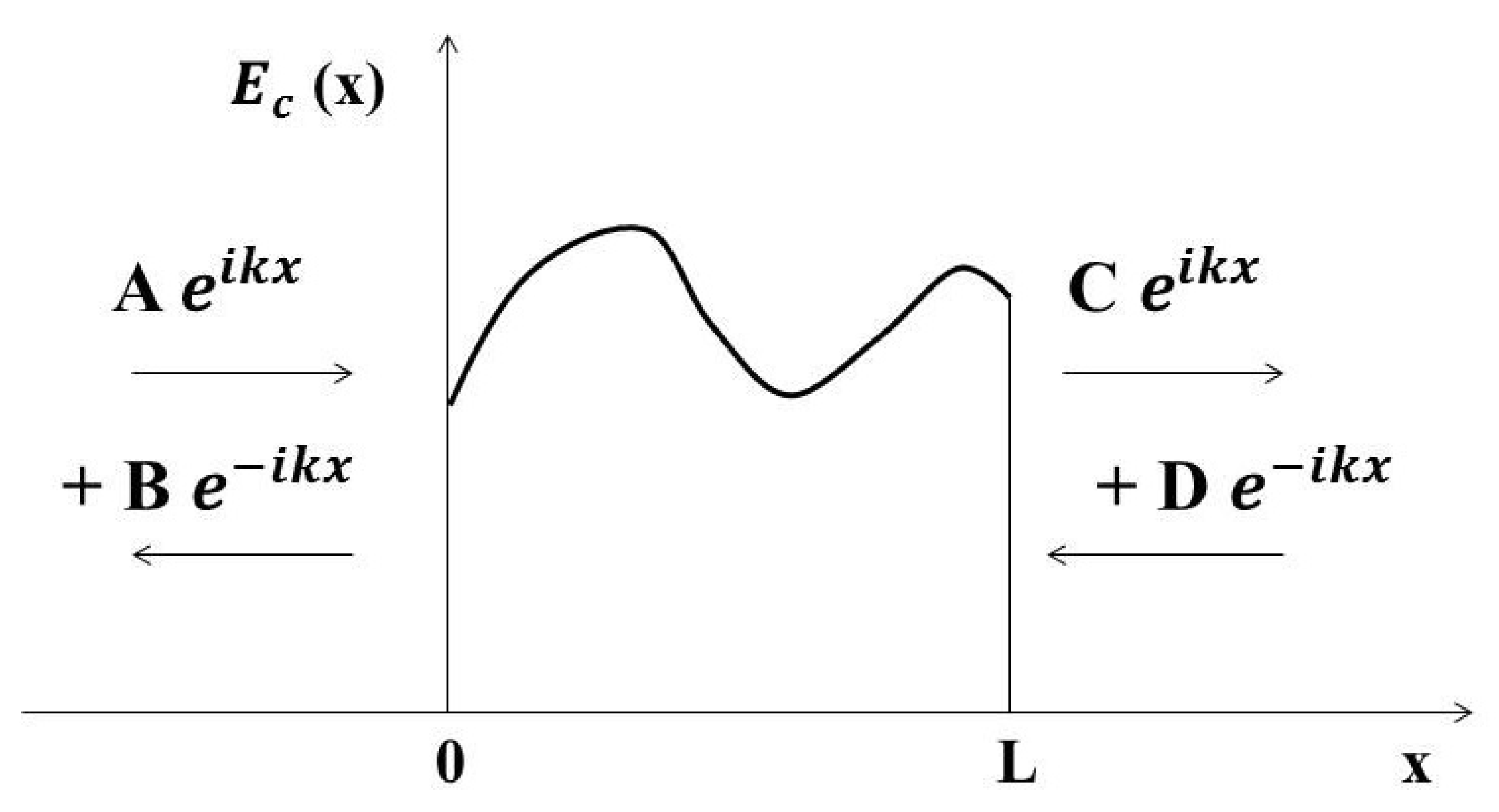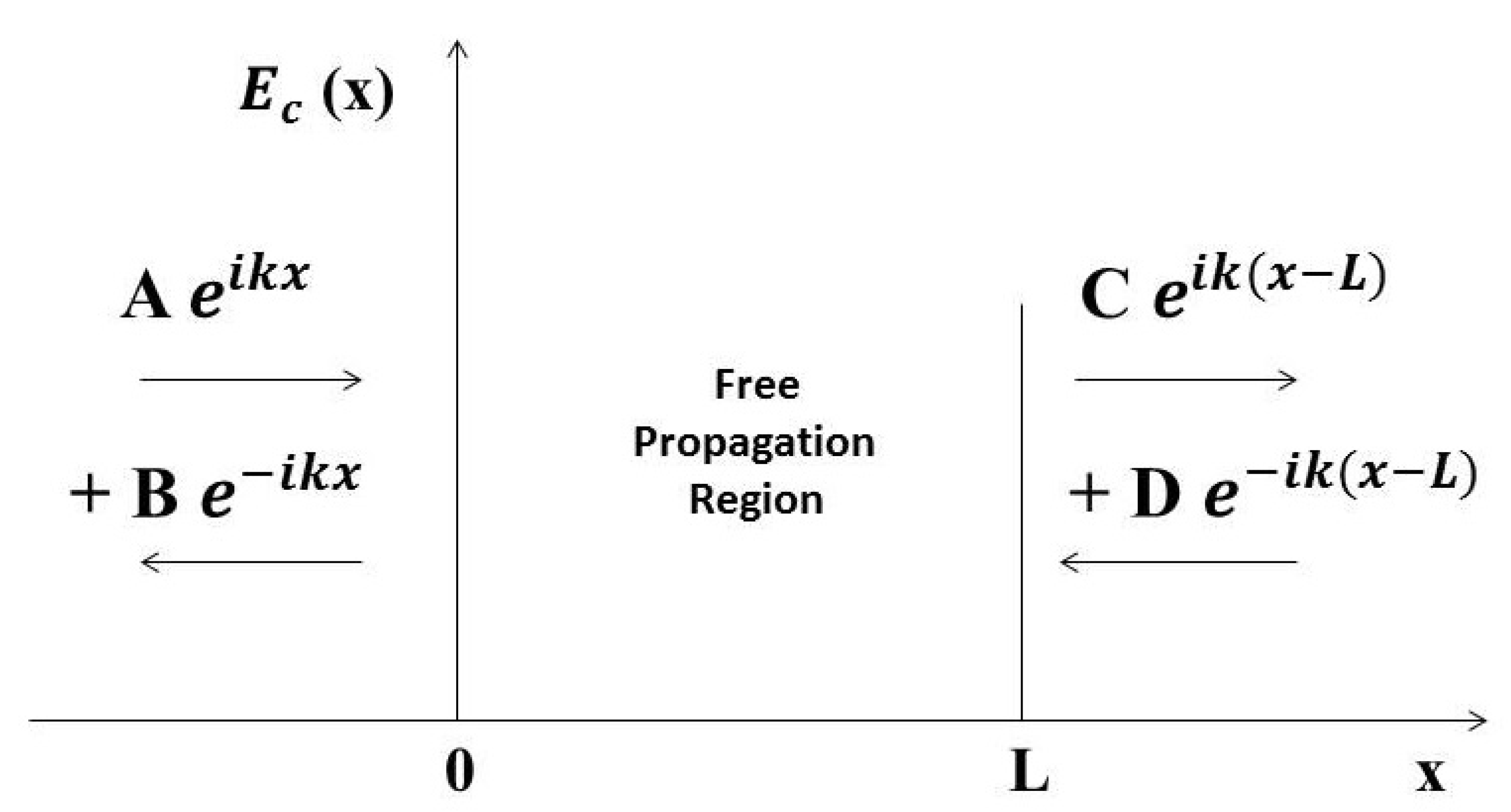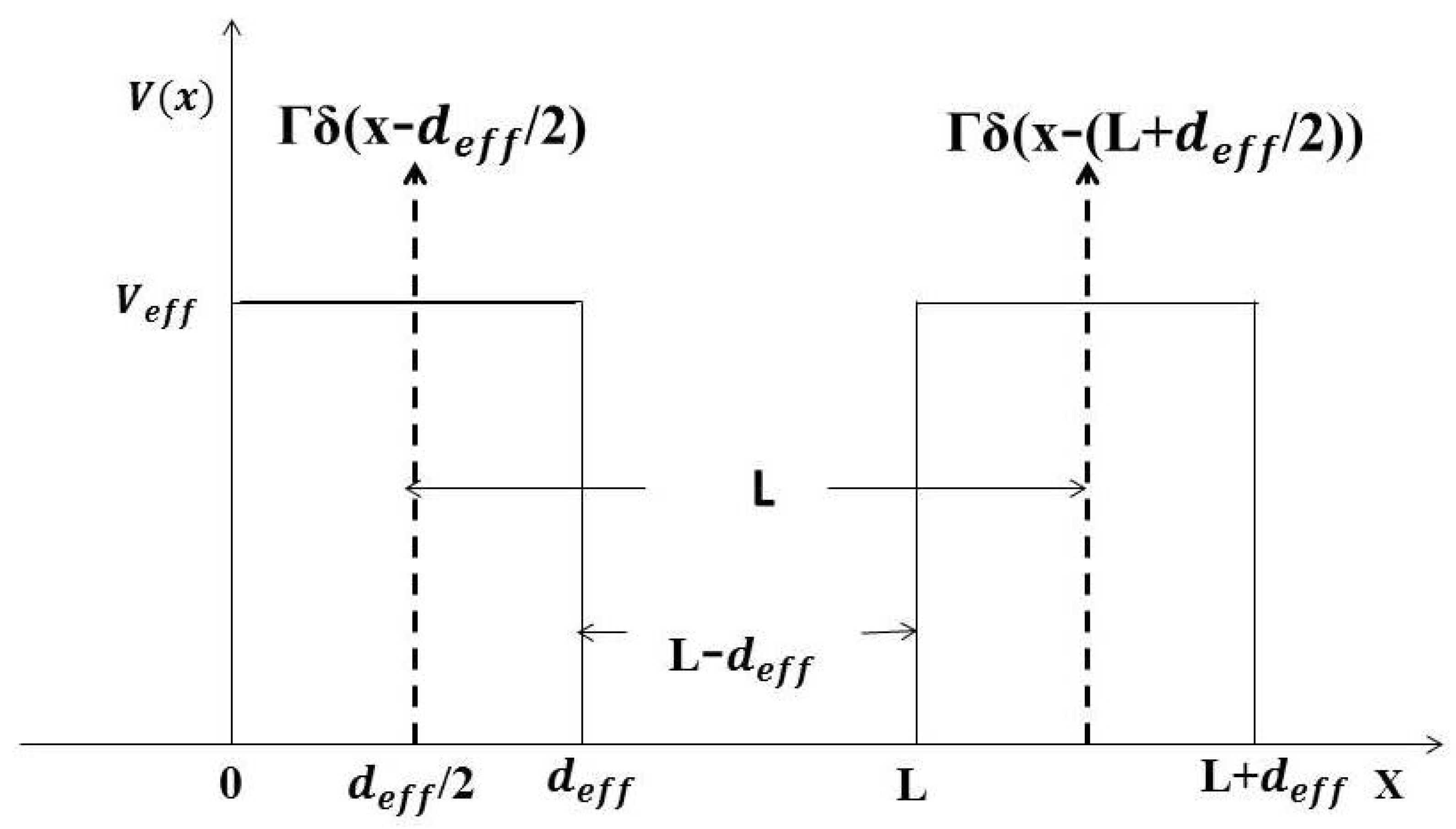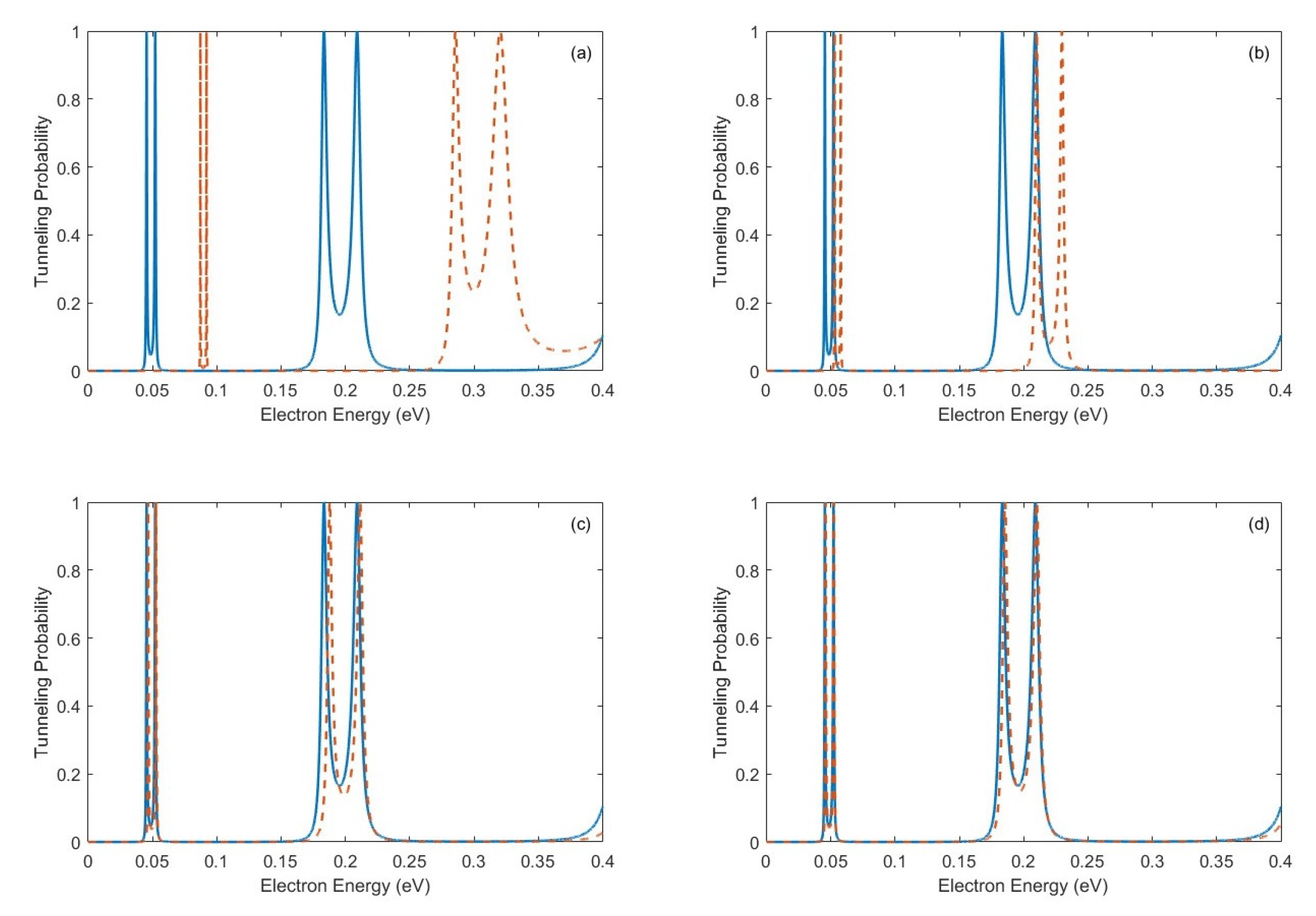A Generalization of Quaternions and Their Applications
Abstract
1. Introduction
2. Generalization of the Quaternion Concept
2.1. Quaternions and Their 4 × 4 Matrix Representations
2.2. Split-Quaternions and Their 4 × 4 Matrix Representation
2.3. The Generalized Quaternion Concept
2.4. Proof That 56 Other Generalized Quaternions Are Not Proper Division Algebras
2.5. Isomorphism between the Non-Commutative Division Algebra
3. Examples of Generalized Quaternion Applications
3.1. Lorentz Boost along the x, y, or z Directions Using Left-Chirality Quaternions
3.2. Lorentz Boost along an Arbitrary Direction Using Left-Chirality Quaternions
3.3. Three Lorentz Boosts along an Arbitrary Direction Using Right-Chirality Quaternions
3.4. Lorentz Invariant
4. A Generalized Split-Quaternion Approach to Tunneling Problems
4.1. Split Quaternion Formulation of Transmission Matrix
4.2. Split-Quaternion Associated to a 1D Delta Scatterer
4.3. Split-Quaternion Associated to a Free Propagation Region of Length L
4.4. Split-Quaternion Associated to a Finite Square Barrier
4.5. Solving Tunneling Problems with Alternative Split-Quaternions
5. Conclusions and Suggestions for Future Work
Author Contributions
Funding
Institutional Review Board Statement
Informed Consent Statement
Data Availability Statement
Conflicts of Interest
References
- Hamilton, W.R. Computer codes used to generate the simulation results are available from the corresponding author. Philos. Mag. 1844, 25, 489. [Google Scholar]
- Morris, D. Quaternions; Abane and Right: Port Mulgrave, UK, 2015. [Google Scholar]
- Ward, J.P. Quaternions and Cayley Numbers: Algebra and Applications; Kluwer Academic, Springer-Science+Business Media, B.V.: Dordrecht, The Netherlands, 1997. [Google Scholar]
- Jafari, M. Quaternions Algebra and Its Applications: An Overview. Int. J. Theor. Appl. Math. 2016, 2, 79. [Google Scholar]
- Adler, S.L. Quaternionic Quantum Mechanics and Quantum Fields; Oxford University Press: New York, NY, USA, 1995. [Google Scholar]
- Arbab, A.I. Derivation of Dirac, Klein-Gordon, Schrödinger, Diffusion and Quantum Heat Transport Equations from a Universal Quantum Wave Equation. Europhys. Lett. 2010, 92, 40001. [Google Scholar] [CrossRef]
- Girard, P.R. The Quaternion Group and Modern Physics. Eur. J. Phys. 1984, 5, 25. [Google Scholar] [CrossRef]
- Cartan, E. The Theory of Spinors; MIT Press: Cambridge, MA, USA, 1966. [Google Scholar]
- Bandyopadhyay, S.; Cahay, M. Introduction to Spintronics, 2nd ed.; CRC Book Press: Boca Raton, FL, USA, 2014. [Google Scholar]
- Nielsen, M.A.; Chuang, I.L. Quantum Computation and Quantum Information; Cambridge University Press: New York, NY, USA, 2000. [Google Scholar]
- Cahay, M.; Purdy, G.; Morris, D. On the Quaternion Representation of the Pauli Spinor of An Electron. Phys. Scr. 2019, 94, 085205. [Google Scholar] [CrossRef]
- Cahay, M.; Morris, D. On the Quaternionic Form of the Pauli- Schrödinger Equation. Phys. Scr. 2020, 95, 015204. [Google Scholar] [CrossRef]
- Cockle, J. On Systems of Algebra Involving More Than One Imaginary; And On Equations of The Fifth Degree. Philos. Mag. 1849, 35, 434. [Google Scholar] [CrossRef]
- Kula, L.; Yayli, Y. Split Quaternions and Rotations in Semi Euclidean Space. J. Korean Math. Soc. 2007, 44, 1313. [Google Scholar] [CrossRef]
- Machen, C. The Exponential of a Quaternion Matrix. Rose-Hulman Undergr. Math. J. 2011, 12, 29. [Google Scholar]
- Özdemir, M. The Roots of a Split Quaternion. Appl. Math. Lett. 2009, 22, 258. [Google Scholar] [CrossRef]
- Özdemir, M.; Ergin, A.A. Rotations with Unit Timelike Quaternions in Minkowski 3-space. J. Geom. Phys. 2006, 56, 322. [Google Scholar] [CrossRef]
- Ujang, B.C.; Took, C.C.; Mandic, D.P. Split Quaternion Nonlinear Adaptive Filtering. Neural Netw. 2010, 23, 426. [Google Scholar] [CrossRef] [PubMed]
- Ata, E.; Yayli, Y. Split Quaternions and Semi-Euclidean Projective Spaces. Chaos Solitons Fractals 2009, 41, 1910. [Google Scholar] [CrossRef]
- Jiang, T.; Jiang, Z.; Zhang, Z. Algebraic Techniques for Diagonalization of a Split Quaternion Matrix In Split Quaternion Mechanics. J. Math. Phys. 2015, 56, 083509. [Google Scholar] [CrossRef]
- Brody, D.C.; Graefe, E.M. On Complexified Mechanics and Coquaternions. J. Phys. A Math. Theor. 2011, 44, 072001. [Google Scholar] [CrossRef]
- Brody, D.C.; Graefe, E.M. Coquaternions Quantum Dynamics for Two-Level Systems. Acta Polytech. 2011, 51, 14. [Google Scholar] [CrossRef]
- Bender, C.M. Coquaternions Quantum Dynamics for Two-Level Systems. Rep. Prog. Phys. 2007, 70, 947. [Google Scholar] [CrossRef]
- Gogberashvili, M. Split Quaternions and Particles in (2+1)-Space. Eur. Phys. J. C 2014, 74, 3200. [Google Scholar] [CrossRef]
- Yormaz, C.; Elamz, S.N.; Simsek, S. Hamiltonian Mechanical System with Split Quaternions. Univers. J. Appl. Math. 2018, 6, 17. [Google Scholar] [CrossRef]
- Antonuccio, F. Split-Quaternions and the Dirac Equation. Adv. Appl. Clifford Algebra 2015, 25, 13. [Google Scholar] [CrossRef][Green Version]
- Thakur, K.; Tripathi, B.P. A Variant of NTRU with Split Quaternions Algebra. Palest. J. Math. 2017, 6, 598610. [Google Scholar]
- Babaarslan, M.; Yayli, Y. Split Quaternions and Spacelike Constant Slope Surfaces in Minkowski 3-space. Int. J. Geom. 2013, 2, 23. [Google Scholar]
- Pop, M.-I.; Cretu, N. Intrinsic Transfer Matrix Method and Split Quaternion Formalism for Multilayer Media. Wave Motion 2016, 65, 105. [Google Scholar] [CrossRef]
- Cahay, M.; Bandyopadhyay, S. Problems in Quantum Mechanics, for Material Scientists, Applied Physicists, and Device Engineers; John Wiley and Sons, Inc.: Hoboken, NJ, USA, 2017. [Google Scholar]
- Jackson, J.D. Classical Electrodynamics, 2nd ed.; Wiley: New York, NY, USA, 1975. [Google Scholar]
- Is This a Quaternion Lorentz Boost? Available online: https://physics.stackexchange.com/questions/28797/is-this-a-quaternion-lorentz-boost (accessed on 11 October 2021).
- Maxwell, J.C. A Dynamic Theory of The Electromagnetic Field, Philosophical Transactions of the Royal Society of London. R. Soc. Trans. 1865, 155, 459. [Google Scholar]
- Maxwell, J.C. A Treatise on Electricity and Magnetism; Clarendon Press: Oxford, UK, 1973. [Google Scholar]
- Morris, D. The Physics of Empty Space; Abana and Right: Port Mulgrave, UK, 2015. [Google Scholar]
- Kravchenko, V. Quaternionic equation for electromagnetic fields in homogeneous media. arXiv 2002, arXiv:math-phys/0202010. [Google Scholar]
- Jack, P.M. Physical space as a quaternion structure, I: Maxwell equations. A Brief Note. arXiv 2003, arXiv:math-phys/0307038v1. [Google Scholar]
- Edmonds, J.D. Quaternionic Quantum Theory: New Physics or Number Misticism? Am. J. Phys. 1978, 46, 430. [Google Scholar] [CrossRef]
- Davies, A.J. Quaternionic Dirac Equation. Phys. Rev. D 1990, 41, 2628. [Google Scholar] [CrossRef] [PubMed]
- Schwartz, C. Relativistic Quaternionic Wave Equation. J. Math. Phys. 2006, 47, 122301. [Google Scholar] [CrossRef]
- Sobhani, H.; Hassanabadi, H. Quaternionic Dirac Equation. Can. J. Phys. 2016, 94, 262. [Google Scholar] [CrossRef]
- Schuricht, D.; Greiter, M. Contemplations on Dirac’s Equation in Quaternionic Coordinates. Eur. J. Phys. 2004, 25, 755. [Google Scholar] [CrossRef][Green Version]
- Peres, N.M.R. Scattering in One-Dimensional Heterostructures Described by the Dirac Equation. J. Phys. Condens. Matter 2009, 21, 095501. [Google Scholar] [CrossRef] [PubMed]





| Multiplication | Possible Products |
|---|---|
| −1 | −1 | −1 | k | i | j | −k | −i | −j | |||
| −1 | −1 | −1 | −k | −i | −j | k | i | j | |||
| 1 | 1 | −1 | k | −i | −j | −k | i | j | |||
| 1 | 1 | −1 | −k | i | j | k | −i | −j | |||
| 1 | −1 | 1 | k | i | −j | −k | −i | j | |||
| 1 | −1 | 1 | −k | −i | j | k | i | −j | |||
| −1 | 1 | 1 | −k | i | −j | k | −i | j | |||
| −1 | 1 | 1 | k | −i | j | −k | i | −j |
| Left | |||
| Right | |||
| Left | |||
| Right | |||
| Left | |||
| Right |
Publisher’s Note: MDPI stays neutral with regard to jurisdictional claims in published maps and institutional affiliations. |
© 2022 by the authors. Licensee MDPI, Basel, Switzerland. This article is an open access article distributed under the terms and conditions of the Creative Commons Attribution (CC BY) license (https://creativecommons.org/licenses/by/4.0/).
Share and Cite
Lin, H.-Y.; Cahay, M.; Vellambi, B.N.; Morris, D. A Generalization of Quaternions and Their Applications. Symmetry 2022, 14, 599. https://doi.org/10.3390/sym14030599
Lin H-Y, Cahay M, Vellambi BN, Morris D. A Generalization of Quaternions and Their Applications. Symmetry. 2022; 14(3):599. https://doi.org/10.3390/sym14030599
Chicago/Turabian StyleLin, Hong-Yang, Marc Cahay, Badri N. Vellambi, and Dennis Morris. 2022. "A Generalization of Quaternions and Their Applications" Symmetry 14, no. 3: 599. https://doi.org/10.3390/sym14030599
APA StyleLin, H.-Y., Cahay, M., Vellambi, B. N., & Morris, D. (2022). A Generalization of Quaternions and Their Applications. Symmetry, 14(3), 599. https://doi.org/10.3390/sym14030599





